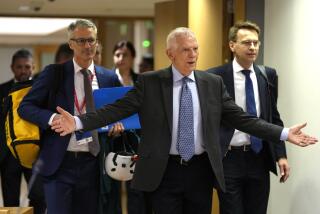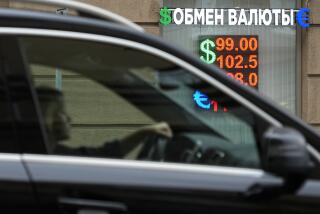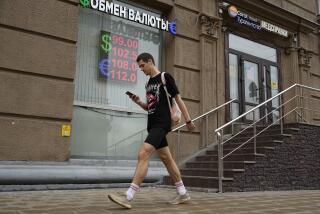International Business : Russian Officials Unleash ‘Collar’ to Keep Unpredictable Ruble in Line : Currency: Plan to give exporters, business people and savers reliability meets with robust skepticism.
- Share via
MOSCOW — In a bold attempt to stabilize the erratic ruble, the Russian government and central bank on Wednesday announced a “collar” to keep the currency from plunging below 4,900 to the dollar before Oct. 1.
The move met approval from Russia’s international lenders, and the finance minister said it had been cleared in advance with the International Monetary Fund. The idea is to provide exporters, business people and savers a reliable currency for the first time in five years, dampen inflation and demonstrate that the Kremlin means to stick to its financial stabilization plan.
“Predictability, that’s what we need,” Russian Prime Minister Viktor S. Chernomyrdin said.
Russian businessmen and consumers reacted with robust skepticism--but one tinged with a tentative hope that this time the Kremlin might keep its promise.
“This is a great test for the prestige and standing of this government,” said Dmitry N. Sopin, a real estate and trading entrepreneur. “In the next few weeks, we will see how much the most energetic and smartest sector of our society--the businessmen--trust the government.”
Sopin said he would give the central bank the benefit of the doubt “one last time.” If it succeeds, he said, it will trigger a real surge in domestic investment that Russia desperately needs.
The ruble has been on a painful ride to ruin since the collapse of the Soviet Union in 1991, when an American dollar was worth about 90 rubles. Runaway inflation, two botched currency reform efforts and a currency crash last October all helped drive the ruble to a record low of 5,130 to the dollar in May.
But since then the ruble has regained a startling 11% of its value, thanks to lower inflation, new banking rules and heavy intervention by the central bank. It closed at 4,559 to the dollar after trading Wednesday.
Under the collar plan, the central bank will allow the ruble to trade freely between 4,300 and 4,900, but will intervene to keep the currency from jumping beyond that band.
“The big question is, can they enforce it with their capital reserves?” said Peter Derby, president and CEO of Dialog Bank. “If they can, it adds great security and it should drive interest rates down.”
But Derby warned that a number of factors, including ongoing capital flight from Russia, demand for dollars by still-skittish consumers, and the government’s historic propensity for printing money each summer to finance the harvest, will determine whether the plan succeeds.
Finance Minister Vladimir G. Panskov said the central bank will back its decision with $12 billion in hard-currency reserves. Other estimates put the reserves at about $10 billion.
“They are in reasonable shape in order to do this,” a Western financial official said, adding, “Our basic belief is that inflation will come down.”
Though inflation is still running higher than government forecasts, it has fallen steadily from 17.8% in January to 8.9% in March to 6.7% in June. However, most international norms hold that a fixed exchange rate is appropriate only when inflation is held to less than about 1.5% per month.
“They are prisoners of their own illusions about the decline of inflation,” said Mikhail Zadornov, chairman of the Parliament’s budget committee, arguing that a more realistic upper limit would be 5,400 to the dollar.
But free-market guru Yegor T. Gaidar said the move was long overdue.
The initial popularity of the plan will be tested July 19, when the Parliament is to vote on approving the central bank’s acting chairman, Tatyana Paramonova, to the chairman’s post.
More to Read
Sign up for Essential California
The most important California stories and recommendations in your inbox every morning.
You may occasionally receive promotional content from the Los Angeles Times.













